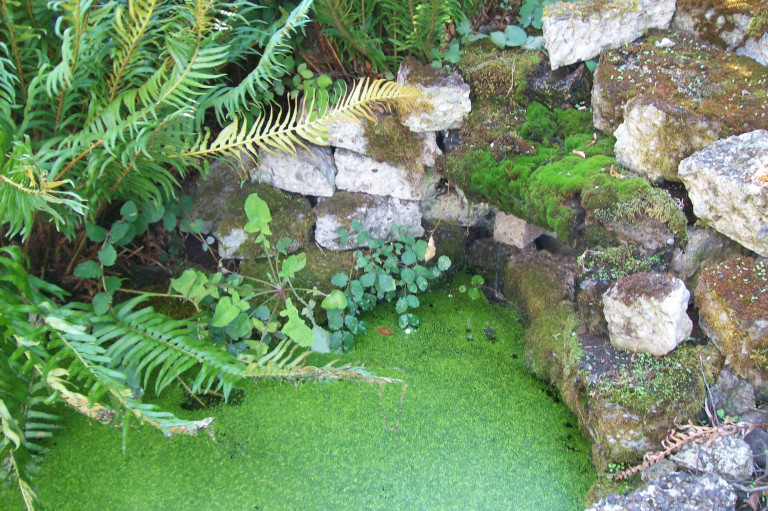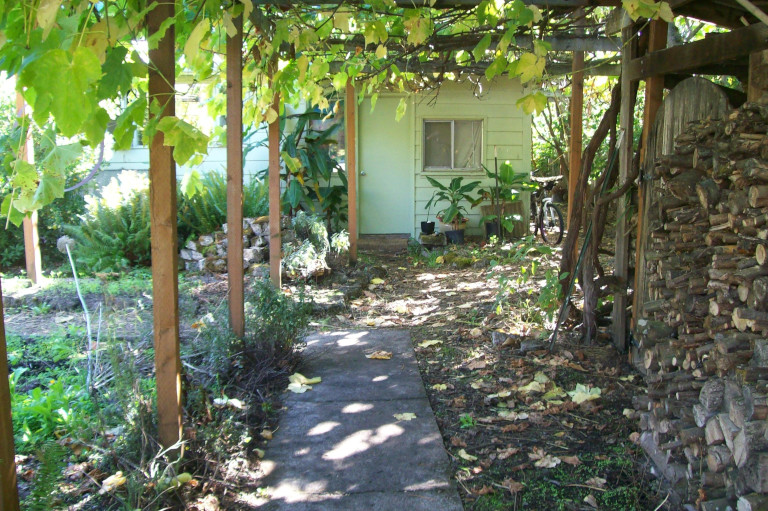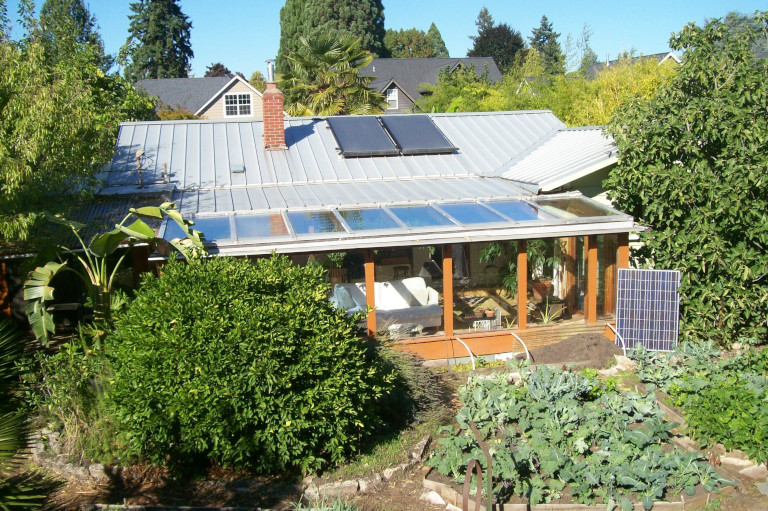From the street, anyone would notice something different about these two properties in the middle of this bi focal suburban block in Eugene, Oregon. The houses on one side of the street date from the mid 50’s, the other side, larger and two stories, have replaced a wholesale nursery over the past 15 years.
The two quarter acre properties of interest here, are green all the way to the street with food producing trees, brambles, vines. One place, notably, does not have a driveway.
My property is a permaculture landmark in the Pacific Northwest. Literally, thousands of people have visited over the years to see what a nothing special suburban property can become. Together, these two properties spark the imagination – what would this street and its culture, look like if all the properties had edible landscaping?
When I bought this place in 2000, the intention from the start was to do a permaculture makeover for several reasons. First, to reduce my eco logical footprint by producing more basic needs on site including food, water, energy, creative expression and aesthetics. I wanted to show what a nothing special suburban property could become, a visible, real life preview of what suburbia can look like on a larger scale when society’s values and goals have adapted to living on a finite planet.
The house is also a source of income. I rent 3 rooms and that, along with a detached passive solar ADU behind the main house helps increase the residential density to help slow down the rate of car dependent suburban sprawl. To advocates of New Urbanism, this is tactical suburban redevelopment. It demonstrates many aspects of permaculture applied to suburbia. The reimagined 50 year old modest suburban home and property points the way towards a preferred future.
When built in the mid 1950’s, the house was a modest two bedroom with 1100 square feet. It is oriented east west with the south side looking to the back yard. The rectangular quarter acre lot is oriented north – south. There are no large trees creating shade although an apple, a cherry and several non food producing trees were removed in the early years to make better use of space.
Transforming a suburban property is both common sense and personal. A location, a climate, rules and regs, reducing eco footprints and and the goal of producing useful products on site meant this place largely designed itself. But my own personal preferences make the outcome unique. A permaculture design course I took when living in Texas in 1990, has also been a big help. In 2003, this place was the first entry on youtube in the category “suburban permaculture.” There are hundreds now.
Home to half of all Americans, many nothing special suburban properties have surprising potentials to work with. Transforming suburbia could create thousands of jobs and benefit people, planet, resilience, social cohesion and sustainability. Many existing design and construction skills like carpenters, electricians, architects, landscapers, can be applied to transforming suburbia along with many kinds of manufacturing jobs for products such as heat pumps, solar hot water heaters, galvalume metal roofing, insulation and more. Transforming suburbia could be a core part of a green restoration economy, culture and society.
This kind of property transformation is within reach of millions of people. With more time than money, I have done most of the work here on my place myself but a typical middle class income could afford to pay for much of the work to be done. Core to that approach is for home owners to establish their own set of priorities for what to do with their own time and money. For example, they could have an edible landscape, sizable rain water collection and storage system, simple passive solar space built, perhaps all of these, instead of a vanity kitchen remodel.
Much of my own reworking this place has paid for itself. Early on, I helped a friend remodel the one car garage into a living space. That turned the home into a three bedroom property. Later, I built a passive solar 400 square foot ADU that is now my living and work space. I do use the house kitchen and bathroom, no need to duplicate those costly expenses. I have been renting those three bedrooms for years and the garage remodel and ADU construction costs have long since been covered.
This project started with sheet mulching the grass with cardboard and compost. I had a garden 8 months after moving in. There is edible landscaping everywhere – apple, pear, peach, fig, mulberry and English Walnut trees. There are trellised grape vines, kiwi, domestic blackberry, boysenberry, culinary herbs. I anticipate climate change with two young olive trees and even a seven foot lemon tree although, at this point, I do need to protect it from the cold a dozen or so nights over the winter. Eugene is a plant hardiness zone 8b closing in on 9a.
There are two 1600 gallon rain water storage tanks plus a 3000 gallon tank added 8 years later. All tanks receive rain water from galvalume metal roofing which I installed, by many accounts, the best kind of surface to collect rain water from. Early on I took out the driveway and replaced it with a storage shed and edible landscaping, including a grape trellis above the roof of the shed and a productive English Walnut tree, now large enough to climb in, where I once parked my pick up truck.
My own smaller footprint lifestyle complements my property. I have been vegetarian for over forty years and no longer own a vehicle. I make time to engage with my neighborhood and community as a board member of my neighborhood association and have a written agreement with the city of Eugene to look after the the well being of a 65 tree filbert grove on public property a few blocks from home.
A single property transformation is great but a sustainable future will call for increasing the scale of creating a new kind of suburbia. I worked with a neighbor removing a ten foot high forty foot long ornamental hedge. We had to work together because the hedge was flat on the property line. Instead of the hedge we now have plums, mulberry, black berries, currants, grapes and more. The project required working together and we both benefit. This is a small example of expanding the scale of transforming suburbia beyond a single property.
There are examples of neighborly collaborations going a lot further than me and my neighbor. Here in Eugene, in Davis, California and across the country, there is a growing number of friends and neighbors taking fences down and integrating their properties in ways beneficial to all involved. These great stories show how people can trade the typical large suburban eco and social footprint lifestyles for a more eco logical, resilient and socially cooperative suburbia.
The future of suburbia and beyond comes down to how we prioritize our own time and money and that is the passport to discovering and making use of surprising allies and assets that can be found in almost any neighborhood and community. A planning group in our neighborhood brought together nearby allies and assets to produce a community event several years ago, advocating suburban transformation that attracted over 700 participants. Every year I see new front yard gardens and hear about new transformation projects within blocks of where I live. Other allies and assets stories for another time.
My 23 year project re imagining and re working this simple quarter acre property has been one of the most creative and rewarding experiences of my life. Thousands of people have visited over the years. My place is a community and regional educational resource. On occasion, people I don’t even know tell me the positive changes they have made to reduce their own eco footprints and produce more basic needs on their own properties.
I threw the frisbee in Golden Gate Park in San Francisco several years ago with total strangers. After the session, we all had a great laugh when we discovered that the young woman among us had been on a site tour of my place a couple years before.
Given the deepening and worrisome trends we all know, the more people making these value, priority, lifestyle and home improvement choices to reduce eco footprints, the better because those actions all complement others doing likewise and they all have a positive effect on almost every social, political, economic and environmental challenge of our time. No need to wait, no permission required. There are many more positive stories about social, economic and environmental regeneration from suburbia, urban and rural locations from all over the country. A preferred future is within reach, sooner than later. The more the better.
Jan’s back yard.
A recent site tour. Literally, thousands of people have visited over the years. Structures in both fotos on my property. I built this one.

Water features add a nice touch. The “rocks” are repurposed driveway. There is a trickle of water from a 1600 gallon rain water tank.

Entering onto the quarter acre property from the street. The sidewalk is the remains of a driveway. The door and window replace a one car garage with a nice living space.

A view of Jan’s back yard and south side of the main house.




